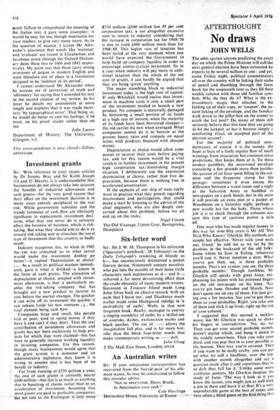Investment grants
Sir: With reference to your recent articles by Dr Jeremy Bray and Sir Keith Joseph (14 and 21 March), it is understandable that businessmen do not always take into account the benefits of industrial allowances and cash grants—for the very good reason that their effect on the investment decision is in many cases entirely peripheral to the real risk. While government subsidies and the trendy formulae of cash flow are obviously significant in replacement investment deci- sions, what they can never do is seriously affect the business of business, which is risk- taking. But what they should aim to do is to reward risk-taking and so stimulate the novel type of investment that this country so badly needs.
Industry recognises this, so when in 1965 the cm was consulted 'as to what carrot would make the investment donkey go better'—it replied 'Depreciation at choice'
. As a result its political masters immedi- ately gave it what it disliked—a lemon in the form of cash grants. The attraction of depreciation at choice, coupled with invest- ment allowances, is that it particularly en, ables the risk-taking company that has brought out a new product to recover its cost before the market changes. The quicker it can write off its investment the qtucker it can release funds for new ventures , e . the vital element being cash flow.
Companies large and small, like people rich or poor, tend to spend money if they have it and can't if they don't. Thus the real contribution of investment allowances and grants has not been exclusively to help pro- jects for which they were claimed—but has been to generally increase working liquidity in investing companies. For this reason, though many businessmen would agree that the grant system is a nonsense and an administrative nightmare, they know it is wrong to assume that it has been of no benefit to industry.
Far from running at £530 pillion a year, the cost of cash grants is currently nearer £600 million—but this is as much as anything due to bunching of claims rather than to an acceleration of investment. Assuming that most grants are paid to profitable companies, the net cost to' the Exchtxplet IS only some £330 million (£600 million less 45 per cent corporation tax), a not altogether excessive sum to return to industry considering that the increase in corporation tax for 1969/70 is due to yield £460 million more than for 1968/69. This higher rate of taxation has been levied at the very moment when one would have expected the Government to help build up company liquidity in order to encourage contra-cyclical investment. So in a year when industry will pay more in addi- tional taxation than the whole of the net cost of grants, it can hardly be argued that they are being 'given' anything.
The major stumbling block to industrial investment today is the high cost of capital. If only Whitehall would realise that invest ment in machine tools is only a small part of the investment needed to launch a new product. No company is materially damaged by borrowing a small portion of its funds at a high rate of interest, when the majority of its funds have been borrowed cheaper— the old carries the new when averaged. What companies cannot do is to borrow at the present heavy rates and compete on equal terms with products financed with cheaper money.
Depreciation at choice would allow corn+ panies to recover their costs before paying tax, and for this reason would be a vital catalyst to further investment in the present high corporation tax/diminishing margin situation. I deliberately use the expression depreciation at choice, rather than free de- preciation, because there is nothing free in accelerated amortisation.
If the captains of our ship of state really want to practice what they preach regarding involvement and participation, they could make a start by listening to the advice of the chief engineers, who are also deeply con.= cerned about this problem; before we all end up on the rocks, Nigel Vinson The Old Vicarage, Upton Grey, Basingstoke, Hampshire


































 Previous page
Previous page